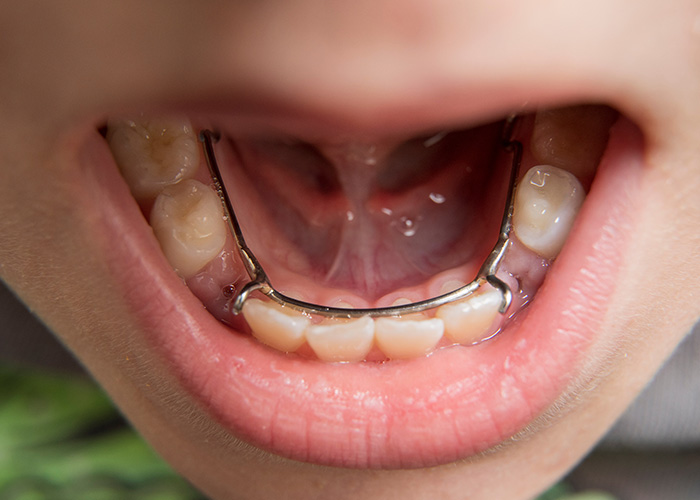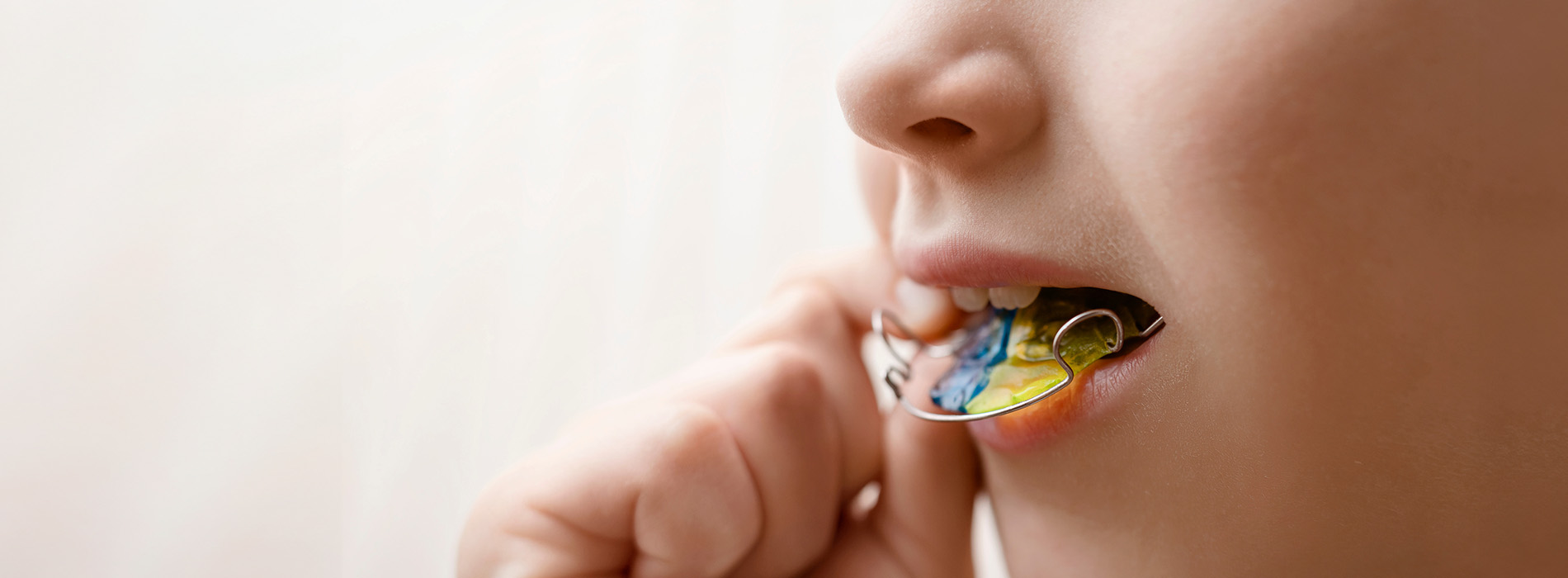
Our Office
2615 West 24th St.
Plainview, TX 79072
Existing Patients: (806) 296-6057
New Patients: (806) 217-7472
Visit Us Online

Baby teeth do much more than make a cute smile — they guide jaw growth, help children learn to eat and speak, and reserve the correct positions for adult teeth. When a primary tooth is lost earlier than expected, it can set off a chain reaction of movement that affects tooth alignment and bite development. This page explains why maintaining space matters, how space maintainers work, and what families can expect when this straightforward preventive treatment is recommended.
Primary teeth act as biological place-holders for permanent teeth. Each baby tooth keeps a carefully measured gap so the larger, permanent tooth can erupt into the correct spot. When that placeholder disappears too early, neighboring teeth may shift into the vacant area. This unintended drifting reduces room for the permanent tooth and can lead to crowding, impaction, or misalignment that may complicate future dental development.
Beyond the mechanical role, primary teeth support natural jaw growth. They help maintain arch length and encourage the jawbones to develop proportionately. Losing a tooth prematurely can subtly change how forces are distributed across the mouth during chewing and growth, potentially influencing the shape of the arch and the space available for other teeth.
Primary teeth are also important for speech and nutrition. Children use these teeth to form sounds and to bite and chew food effectively. Premature tooth loss can create functional gaps that affect how a child pronounces certain sounds or how they chew, which can in turn influence eating habits and confidence during social interactions.
Because of these multiple roles, dental professionals evaluate early tooth loss carefully, considering not just the missing tooth itself but the developmental context — the child’s age, the stage of the underlying permanent tooth, and the overall health of the surrounding teeth and gums.
Not every lost baby tooth requires intervention, but there are clear signs that a space maintainer may be necessary. If the gap is likely to cause adjacent teeth to drift or if the permanent tooth is several years away from erupting, preserving the space becomes a priority. Our team assesses the timing of eruption, the direction of neighboring teeth, and whether shifting could crowd or block the permanent tooth’s path.
Trauma and decay are the most common reasons a child might lose a primary tooth prematurely. A traumatic injury can remove a tooth suddenly, while untreated decay may result in extraction. In either case, the mouth responds quickly: teeth begin to settle into open spaces, and that movement can be difficult to reverse without orthodontic treatment later on.
The decision to place a space maintainer also takes into account the child’s overall oral health. If the neighboring teeth are strong and able to support a band or other retention method, a fixed maintainer may be appropriate. If not, or if the child is older and more cooperative, a removable solution may be considered. The end goal is always to protect the eruption path of the permanent tooth while minimizing disruption to everyday life.
During the evaluation, we use a combination of clinical examination and X-rays to determine the position and development of the permanent tooth below the gum. This helps the dentist recommend the most conservative, effective option for preserving space and promoting healthy development.
A space maintainer is a dental appliance designed to hold open the exact area left by a prematurely lost baby tooth. It performs a simple but critical function: preventing adjacent teeth from drifting into the vacant space. By doing so, it preserves the natural pathway for the underlying permanent tooth so it can erupt in its intended position without obstruction.
Fixed space maintainers are commonly used when neighboring teeth are healthy and provide a reliable anchor. These appliances are cemented in place and require minimal cooperation from the child for daily wear. Because they stay put, they protect the site continuously and are monitored at regular dental visits to ensure they remain intact and functional.
Removable space maintainers offer flexibility for older children who can handle taking the appliance in and out for cleaning. These may be used when multiple teeth are missing or when the clinical situation calls for an appliance that can be adjusted or removed without a dental visit. The choice between fixed and removable always balances effectiveness, comfort, and the child’s ability to comply with care instructions.
Regardless of type, the appliance is removed once the permanent tooth begins to erupt into the space. That timing is important: too early removal can allow unwanted movement, while leaving a device in place after eruption can interfere with natural tooth positioning.
Common fixed options include band-and-loop maintainers, distal shoe appliances, and transpalatal or lingual holding arches, each tailored to different locations in the mouth and stages of dental development. A band-and-loop, for instance, uses a metal band attached to a healthy tooth and a loop to hold the space; it works well for a single missing tooth. A lingual holding arch may be used when multiple lower teeth need stabilization.
Removable maintainers typically resemble partial plates and may include acrylic and wire components. They are more suitable for cooperative children and situations where adjustability is important. These appliances make it easier to maintain oral hygiene and can be taken out for meals or sports, but they rely on the child’s consistency in wearing them as directed.
The selection process begins with a careful exam and X-rays to understand eruption timing and space needs. We also assess tooth stability, gum health, and whether a mouth habit (like thumb-sucking) might influence the outcome. Parental input is important too — we discuss daily care, expected follow-up visits, and what to expect as the permanent tooth develops.
When a space maintainer is chosen, our team explains why that particular design is best for the child’s stage of growth and how it supports long-term oral health. The goal is to use the least invasive, most predictable approach that protects the developing dentition.
Fitting a space maintainer is a routine process adapted to each child. For a fixed appliance, the tooth used as an anchor is prepared and a band is cemented; the maintainer is then shaped and adjusted to sit comfortably. For removable appliances, impressions are taken, and the device is fabricated in a dental lab before being fitted and fine-tuned at a follow-up visit. Most children tolerate the procedure well and quickly adapt to the presence of the appliance.
Caring for a space maintainer focuses on cleanliness and routine observation. Families should encourage regular brushing around the appliance and watch for loose components or signs of irritation. Removable devices should be cleaned daily and stored properly when not in use. Foods that are very sticky or hard may be discouraged for fixed appliances to reduce the risk of dislodgement.
Follow-up appointments are a key part of success. Scheduled visits allow the dentist to monitor the appliance, check the eruption of the permanent tooth, and decide when removal is appropriate. If a maintainer becomes loose or causes discomfort between visits, parents should contact the practice to schedule an evaluation so the appliance can be repaired or adjusted promptly.
When the permanent tooth begins to emerge, the appliance is removed, and the eruption is monitored to ensure the tooth settles into a healthy position. In some cases, a brief period of observation or a minor adjustment is all that’s needed; in others, later orthodontic guidance may be recommended as part of ongoing dental development.
At Texas Super Smiles for Kids, we focus on thoughtful, preventive care that supports ideal dental growth. If your child has lost a primary tooth early or you’re concerned about spacing and eruption, contact us to learn more about whether a space maintainer is the right choice. Our team is happy to provide an individualized evaluation and explain the options in clear, practical terms.
Baby teeth guide jaw growth, help with eating and speaking, and reserve space for permanent teeth. Losing a primary tooth too early can lead to misalignment, crowding, or functional issues if not managed properly.
Adjacent teeth may drift into the empty space, reducing room for the permanent tooth. This can result in crowding, impacted teeth, or bite problems that may require more complex treatment later.
A space maintainer is a dental appliance designed to hold open the space left by a prematurely lost baby tooth. It ensures the permanent tooth has enough room to erupt in its correct position.
Children who lose a primary tooth early due to trauma or decay and have a permanent tooth that is several years away from erupting may benefit from a space maintainer to prevent shifting of neighboring teeth.
There are fixed maintainers (like band-and-loop, distal shoe, or lingual holding arches) and removable maintainers. The choice depends on the child’s age, cooperation level, location of the missing tooth, and oral health.
For fixed appliances, a band is cemented to an anchor tooth and the maintainer is adjusted for comfort. Removable devices are custom-fabricated from impressions and fit during a follow-up visit.
Children should brush around the appliance daily, avoid very sticky or hard foods for fixed maintainers, and clean removable devices as instructed. Parents should monitor for loose parts or irritation.
The appliance is typically removed when the permanent tooth begins to erupt into the space. Timing is important to prevent unwanted tooth movement or interference with natural eruption.
Most children adapt quickly to their space maintainer. Mild awareness of the appliance is normal, and adjustments are made to ensure a comfortable fit.
The permanent tooth is monitored as it erupts to ensure it settles into a healthy position. In some cases, minor adjustments or future orthodontic guidance may be recommended to support ideal dental development.
